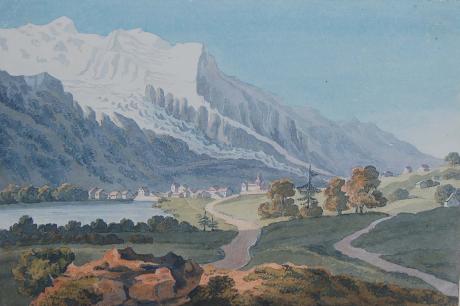Chamonix-Mont-Blanc or, more commonly, Chamonix is a commune in the Haute-Savoie department in the Rhône-Alpes region in southeastern France.It lies at the foot of Mont Blanc. The 1924 Winter Olympics were held at Chamonix. The Chamonix valley runs from northeast to southwest, and is watered by the Arve, which rises in Le Tour. The Arve is joined by the torrent l'Arveyron, which rises in the famous Mer de Glace just above Chamonix. On the southeast towers the snowclad summit of Mont Blanc (4808m), and on the northwest the less lofty, but rugged chain of Le Brévent (2525m) and of the Aiguilles Rouges. A number of villages and hamlets stretched out along the valley belong to the commune including Les Bossons (1012m), Les Praz (1060m), Argentière (1252m) and Le Tour (1462m). The valley is connected via the Col de Montets (1461m) to Martigny (Switzerland) in the Rhône Valley.
The valley was first mentioned in 1091, when it was granted by the Count of the Genevois to the great Benedictine house of St. Michel de la Cluse, near Turin, which by the early 13th century had established a priory there. However, in 1786 the inhabitants bought their freedom from the canons of Sallanches, to whom the priory had been transferred in 1519. In 1530, the inhabitants obtained from the Count of the Genevois the privilege of holding two fairs a year, while the valley was often visited by the civil officials and by the bishops of Geneva (first recorded visit in 1411, while St. Francis de Sales came there in 1606). But travellers for pleasure were very rare. Horace-Benedict de Saussure monument at Chamonix. Beside him is Jacques Balmat.The first party to publish (1744) an account of their visit was that of Dr. Richard Pococke, Mr. William Windham and other Englishmen who visited the Mer de Glace in 1741. In 1742 came P. Martel and several other Genevese, in 1760 H.B. de Saussure, and rather later Marc Th. Bourrit.
The growth of tourism in the early 19th century led to the formation of the Compagnie des Guides de Chamonix in 1821, to regulate access to the mountain slopes (which were communally or co-operatively owned), and this association held a monopoly of guiding from the town until it was broken by French government action in 1892; thereafter guides were required to hold a diploma issued by a commission dominated by civil servants and members of the French Alpine Club rather than local residents. From the late 19th century on, tourist development was dominated by national and international initiatives rather than local entrepreneurs, though the local community was increasingly dependent upon and active in the tourist industry.
The commune successfully lobbied to change its name from Chamonix to Chamonix-Mont-Blanc in 1916. However, following the loss of its monopoly, the Compagnie reformed as an association of local guides, and retained an important role in local society; it provided the services of a friendly society to its members, and in the 20th century many of them were noted mountaineers and popularisers of mountain tourism, for example the novelist Roger Frison-Roche, the first member of the Compagnie not to be born in Chamonix. The holding of the first Winter Olympic Games in Chamonix in 1924 further raised Chamonix's profile as an international tourist destination. By the 1960s, agriculture had been reduced to a marginal activity, while the number of tourist beds available rose to around 60,000 by the end of the 20th century, with about 5 million visitors a year.
Chamonix is a popular winter sports resort town in France. The 1924 Winter Olympics were held there. As the highest European mountain west of Russia, Mont Blanc holds a special allure for mountain climbers, and Jon Krakauer, in an essay in his collection Eiger Dreams, described the town as "the death-sport capital of the world" because Chamonix serves as an ideal playground for almost all types of outdoor activity, especially in their more extreme variants, such as ice climbing, rock climbing, extreme skiing, paragliding, rafting, and canyoning.
Chamonix is famous for its spectacular cable car up to the Aiguille du Midi (3842m). Constructed in 1955 it was then the highest cable car in the world. Together with a cable car system going up to the Point Helbronner (3462m) from Entréves in the Aosta Valley (Italy) it is possible to cross the entire Mont Blanc Massif by cable car. In the summer months Chamonix is a mecca for alpine mountaineers, drawn to the area by challenges like the north face of the Dru, the Frendo Spur on the Aiguille du Midi, traversing the Alps on the legendary GR 5 footpath or more accessible challenges like summitting Mont Blanc (by a number of possible routes). Apart from high-mountain summer sports, Chamonix is also a destination for the hardcore mountain biker. As well as the obvious lift-assisted areas for Freeriders there are hundreds of kilometres of challenging hidden singletrack trails - often only found with the help of guides.

